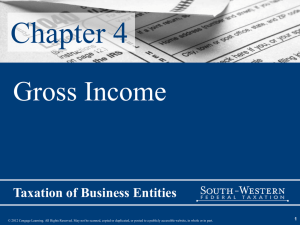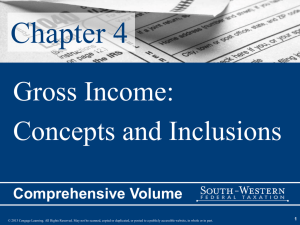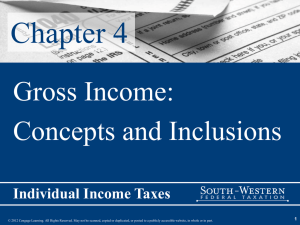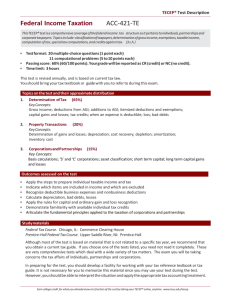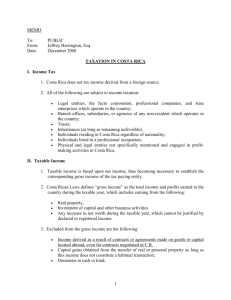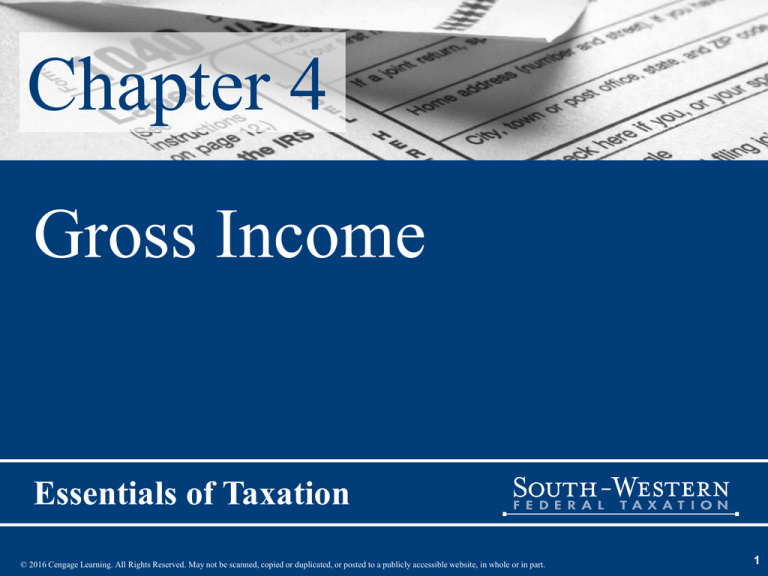
Chapter 4
Gross Income
Essentials of Taxation
© 2016 Cengage Learning. All Rights Reserved. May not be scanned, copied or duplicated, or posted to a publicly accessible website, in whole or in part.
1
The Big Picture (slide 1 of 3)
• Dr. Cliff Payne opens his new dental practice as a
qualified personal service corporation.
– He selects a December 31 year-end and the accrual method
of accounting.
• During the year, Dr. Payne billed patients and
insurance companies for $385,000 of dental services.
– At the end of the year, $52,000 of this amount has not been
collected.
• Dr. Payne also earns the following:
– $500 of interest on a money market account.
– $500 of interest on bonds issued by the Whitehall School
District.
2
The Big Picture (slide 2 of 3)
• Dr. Payne’s salary from his corporation is
$10,000 per month.
– However, he did not cash his December payroll
check until January.
• To help fund his new business, Dr. Payne’s
parents loaned him $150,000
– They did not charge him any interest.
• He also owns stock that has increased in value
from $7,000 at the beginning of the year to
more than $25,000 at the end of the year.
3
The Big Picture (slide 3 of 3)
• Although Dr. Payne took several accounting
classes in college, he would like your help in
calculating his gross income and the gross
income of the corporation.
• Read the chapter and formulate your response.
4
Components Of The Tax Formula
(slide 1 of 3)
5
Components Of The Tax Formula
(slide 2 of 3)
• Income (Broadly Conceived)
– Includes all income, both taxable and nontaxable
• Essentially equivalent to gross receipts
• Does not include
– A return of capital, or
– Borrowed funds
• Exclusions
– Certain types of income are excluded from the income tax
base
• Principal income exclusions that apply to all entities are
– Life insurance proceeds
– State and local bond interest
6
Components Of The Tax Formula
(slide 3 of 3)
• Deductions
– Generally, all ordinary and necessary trade or business
expenses are deductible
– Such expenses include
•
•
•
•
•
•
•
•
Cost of goods sold
Salaries
Wages
Operating expenses (such as rent and utilities)
Research and development expenditures
Interest,
Taxes,
Cost recovery (Depreciation, amortization, and depletion)
7
Gross Income (slide 1 of 3)
• Definition: Gross income includes all income
from whatever source derived, unless
specifically excluded under the Code
• Concept is interpreted broadly by the courts
8
Gross Income (slide 2 of 3)
• Taxability of income follows the realization
principle from accounting
– Income is recognized (taxed) when realized
• Mere appreciation in wealth (economic
income) is not considered realized income
9
Gross Income (slide 2 of 3)
• Taxability of income follows the realization
principle from accounting
– Income is recognized (taxed) when realized
• Mere appreciation in wealth (economic
income) is not considered realized income
10
Gross Income (slide 2 of 3)
• Taxability of income follows the realization
principle from accounting
– Income is recognized (taxed) when realized
• Mere appreciation in wealth (economic
income) is not considered realized income
11
Gross Income (slide 2 of 3)
• Taxability of income follows the realization
principle from accounting
– Income is recognized (taxed) when realized
• Mere appreciation in wealth (economic
income) is not considered realized income
12
The Big Picture - Example 2
Economic Income vs. Gross Income
• Return to the facts of The Big Picture on p. 4-1.
• Dr. Payne’s portfolio has increased in value by more
than 250% during the tax year.
– That additional value constitutes economic income to him.
• The Federal income tax law does not include the
value increase in Dr. Payne’s gross income
– Even though he could convert those gains to cash through,
say, a margin loan from his broker.
13
The Big Picture - Example 2
Economic Income vs. Gross Income
• Return to the facts of The Big Picture on p. 4-1.
• Dr. Payne’s portfolio has increased in value by more
than 250% during the tax year.
– That additional value constitutes economic income to him.
• The Federal income tax law does not include the
value increase in Dr. Payne’s gross income
– Even though he could convert those gains to cash through,
say, a margin loan from his broker.
14
Gross Income (slide 3 of 3)
• Income is recognized whether it is in the form
of cash, or “in-kind” cash equivalents (i.e.,
property or services)
– The amount of income from “in-kind” receipts is
equal to the FMV of the property or services
• Income does not include recovery of the
taxpayer’s capital investment
15
Accounting Periods
• Taxable year is generally a 12-month period
– Taxable year for most individual taxpayers is the
calendar year
– Fiscal year can be elected if taxpayer maintains
adequate records
• Fiscal year is a 12-month period ending on the last day
of a month other than December
– Example: July 1 to June 30
16
Accounting Methods (slide 1 of 2)
• There are 3 primary methods of accounting for
tax purposes:
– Cash receipts and disbursements method
– Accrual method
– Hybrid method
17
Accounting Methods (slide 2 of 2)
• In addition to overall accounting methods,
taxpayers may choose (elect) tax treatment for
various transactions, for example
– Taxpayers can elect to use the installment method
– Certain contractors may elect to use either the
percentage of completion method or the completed
contract method
18
Cash Receipts Method
• Income is recognized in the year it is actually
or constructively received in cash or cash
equivalent
• An amount is constructively received when it
is set aside and made available to taxpayer
without substantial restrictions
19
Exceptions To Cash
Receipts Method
• Original Issue Discount (OID) interest is
taxable when earned rather than when interest
is received
• Savings bonds are not subject to the OID rules
– However, a cash basis taxpayer may elect to
recognize the interest when earned
20
Accrual Method (slide 1 of 2)
• Income is recognized in the year that it is earned
regardless of when it is collected
• Income is earned when:
– All events have occurred that fix taxpayer’s right to the
income, and
– The amount can be determined with reasonable accuracy
• The accrual method is required for determining
purchases and sales when inventory is an incomeproducing factor
21
Accrual Method (slide 2 of 2)
• Claim of right doctrine
– Requires amounts received to be included in
income even though the amount is in dispute and
might be returned to the payor at a later date
– If payment has not been received, no income is
recognized until the claim is settled
22
Exceptions to Accrual Method
(slide 1 of 2)
• Taxpayer can elect to defer recognition of
income from advance payment for goods if
same method of accounting is used for tax and
financial reporting purposes
23
Exceptions to Accrual Method
(slide 2 of 2)
• Advance payment for services to be performed
after year-end is included in income in the year
following receipt
– The portion of the advance payment that is earned
in the current year is included in income in the
year of receipt
• Prepaid rents or interest income are always
recognized in the year received rather than
when earned
24
Example 17 - Advance Payment
For Services (slide 1 of 2)
25
Example 17 - Advance Payment
For Services (slide 2 of 2)
26
Hybrid Method
• A combination of cash and accrual methods
• Generally, used when inventory is a material
income-producing factor
– Use accrual method to account for inventory
– Use cash method for other income and expenses
27
Income Sources
• Income from personal services is taxable to the
person who performs the services
– Fruit and tree metaphor
• Income from property is taxable to the owner
of the property
– Assignment of income is not permitted
28
The Big Picture - Example 18
Personal Service Income (slide 1 of 2)
• Return to the facts of The Big Picture on p. 4-1.
• Assume that Dr. Payne entered into an employment
contract with his corporation and receives a salary.
• All patients contract to receive their services from the
corporation.
– Those services are provided through the corporation’s
employee, Dr. Payne.
29
The Big Picture - Example 18
Personal Service Income (slide 2 of 2)
• The corporation earns the income from
patients’ services and must include the
patients’ fees in its gross income.
• Dr. Payne includes his salary in his own
gross income.
– The corporation claims a deduction for the
reasonable salary paid to Dr. Payne.
30
Interest Income
• Interest income accrues daily
– If interest bearing instrument (e.g., bonds) is
transferred, must allocate interest income between
transferor and transferee based on the number of
days during the period that each owned the
property
31
Dividends (slide 1 of 4)
• Dividends are generally taxed to the party who
is entitled to receive them
– Dividends on stock transferred by gift after
declaration date but before record date are
generally taxed to the donor
32
Dividends (slide 2 of 4)
• Recent legislation has provided partial relief
from double taxation of corporate dividends
– Generally, qualified dividends are taxed at the
same marginal rates applicable to a net capital gain
• Thus, individuals otherwise subject to the 10% or 15%
marginal tax rates in 2013 pay 0% tax on qualified
dividends received
• Individuals subject to the 25, 28, 33, or 35 percent
marginal tax rates pay a 15% tax on qualified dividends
• Individuals subject to the 39.6% marginal tax rate pay a
20% tax on qualified dividends
33
Dividends (slide 3 of 4)
• The following dividends are not eligible for
the reduced tax rates
– Dividends from certain foreign corporations,
– Dividends from tax-exempt entities, and
– Dividends that do not satisfy the holding period
requirement
• Stock on which the dividend is paid must have been
held for more than 60 days during the 121-day period
beginning 60 days before the ex-dividend date to qualify
for the reduced tax rates
34
Dividends (slide 4 of 4)
• Dividends from foreign corporations are
eligible for qualified dividend status only if:
– The foreign corporation’s stock is traded on an
established U.S. securities market, or
– The foreign corporation is eligible for the benefits
of a comprehensive income tax treaty between its
country of incorporation and the United States
35
Income Received By An Agent
• Income received by the taxpayer’s agent is
considered to be received by the taxpayer
– A cash basis principal must recognize the income
at the time it is received by the agent
36
Income Received By An Agent
• Income received by the taxpayer’s agent is
considered to be received by the taxpayer
– A cash basis principal must recognize the income
at the time it is received by the agent
37
Imputed Interest on Below-Market Loans
(slide 1 of 4)
• Interest is imputed, using Federal government rates,
when a loan does not carry a market rate of interest
– Imputed interest = the difference between the amount that
would have been charged at the Federal rate and the
amount actually charged
• Applies to:
•
•
•
•
Gift loans
Compensation-related loans
Corporate-shareholder loans
Tax avoidance loans
38
Imputed Interest on Below-Market Loans
(slide 2 of 4)
Exhibit 4.1
39
Imputed Interest on Below-Market Loans
(slide 3 of 4)
• Gift loans
– Exemption for loans of ≤ $10,000 between
individuals
• If loan proceeds are used to purchase income-producing
property, the following limitation applies
– On loans of $100,000 or less between individuals
• Imputed interest is limited to borrower’s net investment
income for year
• No imputed interest if net investment income is $1,000
or less
40
Imputed Interest on Below-Market Loans
(slide 4 of 4)
• $10,000 exemption also applies to
compensation-related and corporationshareholder loans
– No exemption if principal purpose of loan is tax
avoidance
• Makes practically all loans of this type suspect
• Interest expense imputed to borrower may be
deductible
41
The Big Picture - Example 28
Imputed Interest On Gift Loans
• Return to the facts of The Big Picture on p. 4-1.
• Dr. Payne’s loan from his parents likely is a gift loan,
as his parents are not shareholders in the personal
service corporation.
• Imputed interest must be computed annually with
regard to this loan by both Dr. Payne and his parents
– The principal amount of the loan exceeds $100,000 and
– The loan proceeds were invested in an income-producing
asset.
42
Tax Benefit Rule
• If taxpayer receives a deduction for an item in
one year and in a later year recovers all or a
portion of the prior deduction, the recovery is
included in gross income
– Amount included in income is limited to the
amount for which a tax benefit was received
43
Tax Benefit Rule
• If taxpayer receives a deduction for an item in
one year and in a later year recovers all or a
portion of the prior deduction, the recovery is
included in gross income
– Amount included in income is limited to the
amount for which a tax benefit was received
44
Interest on State and Local
Government Obligations
• Interest from municipal bonds is tax exempt
– Reduces borrowing costs of state and local
governments
– High-income taxpayers can increase after-tax
yields with municipal bonds
– Municipal interest is considered for Social Security
benefits inclusion and may be considered for
alternative minimum tax calculation
45
Interest on State and Local
Government Obligations
• Interest from municipal bonds is tax exempt
– Reduces borrowing costs of state and local
governments
– High-income taxpayers can increase after-tax
yields with municipal bonds
– Municipal interest is considered for Social Security
benefits inclusion and may be considered for
alternative minimum tax calculation
46
Interest on State and Local
Government Obligations
• Interest from municipal bonds is tax exempt
– Reduces borrowing costs of state and local
governments
– High-income taxpayers can increase after-tax
yields with municipal bonds
– Municipal interest is considered for Social Security
benefits inclusion and may be considered for
alternative minimum tax calculation
47
The Big Picture - Example 33
Tax Exempt Municipal Bonds Interest
• Return to the facts of The Big Picture on p. 4-1.
• Dr. Payne includes in gross income the $500
of interest income from the bank’s money
market account, but not the $500 that is earned
on the Whitehall School District bonds.
48
Improvements on
Leased Property
• Improvements made to leased property
– Excluded from landlord’s gross income unless the
improvement is made to the property in lieu of rent
49
Life Insurance Proceeds
(slide 1 of 4)
• Exempt income to beneficiary if paid solely
due to death of insured
– Relationship to decedent not determinative
50
Life Insurance Proceeds
(slide 2 of 4)
• If owner of life insurance policy cancels the
policy and receives the cash surrender value
– Gain must be recognized to extent amount
received exceeds premiums paid on policy
– Loss is not recognized
51
Life Insurance Proceeds
(slide 3 of 4)
• Transfers for valuable consideration
– If policy is transferred for valuable consideration,
proceeds are taxable to extent they exceed amount
paid for policy plus subsequent premiums paid
– Exceptions exist for policy transfers:
• To facilitate funding of buy-sell agreements,
• Pursuant to a tax-free exchange, and
• For receipt of a policy by gift
52
Life Insurance Proceeds
(slide 3 of 4)
• Transfers for valuable consideration
– If policy is transferred for valuable consideration,
proceeds are taxable to extent they exceed amount
paid for policy plus subsequent premiums paid
– Exceptions exist for policy transfers:
• To facilitate funding of buy-sell agreements,
• Pursuant to a tax-free exchange, and
• For receipt of a policy by gift
53
Life Insurance Proceeds
(slide 4 of 4)
• Investment earnings arising from the
reinvestment of life insurance proceeds are
generally subject to income tax
– e.g., Beneficiary elects to collect the insurance
proceeds in installments
• The interest portion of each installment is included in
gross income
54
Discharge from Indebtedness
• Income from the forgiveness of debt is taxable
– Certain discharge of indebtedness situations get special
treatment:
•
•
•
•
•
•
•
•
Creditors’ gifts
Discharges in bankruptcy and when debtor is insolvent
Discharge of farm debt
Discharge of qualified real property business indebtedness
Seller’s cancellation of buyer’s debt
Shareholder’s cancellation of corporation’s debt
Forgiveness of certain student loans
Discharge of indebtedness on taxpayer’s principal residence that
occurs between 2007 and 2014, and is the result of the financial
condition of the debtor
55
Discharge from Indebtedness
• Income from the forgiveness of debt is taxable
– Certain discharge of indebtedness situations get special
treatment:
•
•
•
•
•
•
•
•
Creditors’ gifts
Discharges in bankruptcy and when debtor is insolvent
Discharge of farm debt
Discharge of qualified real property business indebtedness
Seller’s cancellation of buyer’s debt
Shareholder’s cancellation of corporation’s debt
Forgiveness of certain student loans
Discharge of indebtedness on taxpayer’s principal residence that
occurs between 2007 and 2014, and is the result of the financial
condition of the debtor
56
Discharge from Indebtedness
• Income from the forgiveness of debt is taxable
– Certain discharge of indebtedness situations get special
treatment:
•
•
•
•
•
•
•
•
Creditors’ gifts
Discharges in bankruptcy and when debtor is insolvent
Discharge of farm debt
Discharge of qualified real property business indebtedness
Seller’s cancellation of buyer’s debt
Shareholder’s cancellation of corporation’s debt
Forgiveness of certain student loans
Discharge of indebtedness on taxpayer’s principal residence that
occurs between 2007 and 2014, and is the result of the financial
condition of the debtor
57
Gains and Losses from Property
Transactions (slide 1 of 3)
• In order for gains (losses) to be recognized
(included in gross income), they must be
realized:
– Realized gain (loss) = amount realized – adjusted
basis
• Amount realized = selling price – costs of disposition
• Adjusted basis = cost + capital additions – cost recovery
58
Gains and Losses from Property
Transactions (slide 2 of 3)
• All realized gains are recognized unless a
specific tax provision provides otherwise (e.g.,
nontaxable exchanges)
• Realized losses may or may not be recognized
depending on the circumstances
– Generally, losses on the sale or disposition of
personal use property are not recognized
59
Gains and Losses from Property
Transactions (slide 3 of 3)
• Once recognized gains or losses have been
determined, they must be classified as
ordinary or capital
– Ordinary gains are fully taxable
– Ordinary losses are fully deductible
• Capital gains and losses are subject to special
tax treatment
60
Gains and Losses from Capital Asset
Transactions (slide 1 of 2)
• Capital assets are defined as any property other than:
–
–
–
–
Inventory,
Accounts Receivable, and
Depreciable property or real property used in a business
Certain other property
• Most personal use assets owned by individuals are
capital assets
– Losses on these assets are not deductible
61
Gains and Losses from Capital Asset
Transactions (slide 2 of 2)
• Gains and losses from capital asset
transactions must be netted
– Net gains and losses by holding period
– If excess losses result, tax treatment depends on
whether taxpayer is an individual or corporation
62
Max Tax Rates for Net Capital
Gains of Individuals
Classification
Maximum Rate
Short-term gains (held ≤ one year)
35%
Long-term gains (held > one year) 0%/15%/20%
63
Treatment of Capital Losses
(slide 1 of 2)
• Net capital losses of individuals are deductible
for AGI up to $3,000 yearly
– Excess capital losses are carried over to the next
tax year
– When carried over, capital losses retain their
classification as short- or long-term
64
Treatment of Capital Losses
(slide 2 of 2)
• Corporations must also net capital gains and
losses
– Net capital gains do not receive special tax
treatment
– Capital losses can only offset capital gains
• Excess capital losses may not be deducted against
ordinary income
• Unused capital losses can be carried back 3 years and
then carried forward 5 years to offset capital gains in
those years
65
Refocus On The Big Picture (slide 1 of 4)
• Using the accrual method of accounting, the
gross income recognized by Dr. Cliff Payne’s
corporation would be $385,500.
– This includes the entire $385,000 of revenue
earned from providing services to patients during
the year and the $500 of interest income earned on
the money market account.
• The $500 of school district bond interest is excluded
from gross income.
66
Refocus On The Big Picture (slide 2 of 4)
• Dr. Payne’s gross income includes $120,000 of salary
earned during the year.
– Even though he did not cash his December paycheck until
January.
• He constructively received the income since it was readily available
to him.
• Dr. Payne may be able to reduce his taxable income
by the imputed interest expense on the below-market
loan from his parents.
• The increase in value on his stock does not result in
gross income until he sells the stock and realizes a
gain or loss.
67
Refocus On The Big Picture (slide 3 of 4)
What If?
• Rather than electing the accrual method, what
if Dr. Payne had chosen to use the cash method
of accounting for his business?
– Using the cash method is acceptable for certain
personal service corporations.
68
Refocus On The Big Picture (slide 4 of 4)
What If?
• While using the cash method would reduce the
company’s gross income from $385,000 to
$333,000 ($385,000 amount billed less
$52,000 still to be received), this is only part
of the picture.
• Using the cash method also might result in
some of the corporation’s expenses not being
deducted until they are paid in a future year.
69
If you have any comments or suggestions concerning this
PowerPoint Presentation for South-Western Federal
Taxation, please contact:
Dr. Donald R. Trippeer, CPA
trippedr@oneonta.edu
SUNY Oneonta
© 2016 Cengage Learning. All Rights Reserved. May not be scanned, copied or duplicated, or posted to a publicly accessible website, in whole or in part.
70

